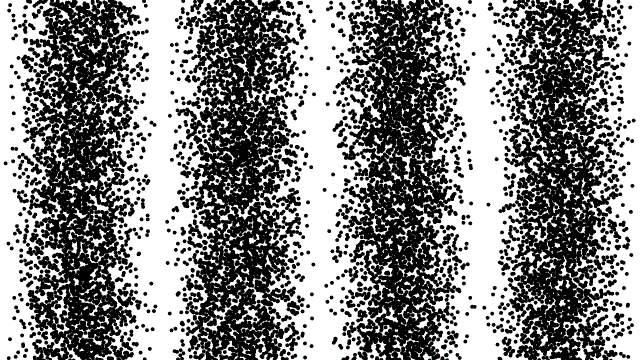Louis Broglie and the Idea of Wave-Particle Duality
Broglie devised that all matter had properties of both waves and particles.
In the early 1900s, a French physicist came up with a new idea to explain the theory of atomic structures. That physicist was a man by the name of Louis de Broglie.
Broglie hypothesized that particles could take on the properties of waves. Broglie’s theory turned out to be correct and was confirmed a few years later in one of the most famous light experiments of all time, the double-slit experiment.
By confirming the theory that particles could act as waves simultaneously, physicists had discovered that electron streams act the same way as light.
What is wave-particle duality?
Electrons, negatively charged electronic particles, can act as both waves and particles. This is known as wave-particle duality.
Wave-particle duality doesn’t have a massive impact on electrons as a whole, but it does help physicists understand many of the strange behaviors that electrons present.
The concept of wave-particle duality is one that is central to quantum mechanics. It helps physicists fill in the gap to what can’t easily be understood by traditional physics interpretations.
RELATED: SCIENTISTS CONFIRM SUBATOMIC PARTICLE PATTERNS USING LARGE HADRON COLLIDER OPEN DATA
The idea of wave-particle duality dates all the way back to the 1600s when Isaac Newton and Christian Huygens were proposing various theories about the properties of light. Einstein also heavily worked on the concept and of course, Louis de Broglie pioneered the theory in his time.
Today, it’s thoroughly established that all objects have natures relating to both waves and particles. However, while this may be the case technically, we can’t really observe the effects of this concept unless we look at very small scales, such as atoms.
In 1924, Broglie developed his theory of electron waves, which was the idea that matter might have the properties of waves on the atomic scale, rooted in Einstein’s earlier theories. The duality of light was first starting to develop but it was Broglie that took this idea and extended it to all of matter. Broglie pioneered the idea of the duality of matter through wave-particle duality.

With everything having both wave and particle natures, the next thing we need to ponder is how light behaves.
Is light a particle or a wave?
In the spirit of wave-particle duality, light is technically both a particle and a wave. However, light is also not a wave or a particle. Light is conceptually an entirely new complex existence.
Think about it this way. If you hold a cylinder up in the air letting a shadow cast down, you’ll be presented with two different shapes. Hold it one way and you’ll be presented with a rectangle. Hold it another and you’ll be presented with a circle. If you examine the shapes of the shadows individually, you’ll be left with technically accurate but wholly incomplete views of the original object. A cylinder is neither a circle nor a rectangle but it’s also both. This is in the same manner that light is neither a particle nor a wave but is also technically both.
Thinking a little deeper about the flaw in the shadows’ representations of the cylinder, they’re incomplete because they’re not working in the same dimensions. A cylinder is a 3D object that can’t fully be explained by 2-dimensional shadows.
RELATED: 9 AMAZING FACTS ABOUT PARTICLE ACCELERATORS AND HOW THEY WORK THAT WILL BLOW YOUR MIND
When we examine light on a quantum scale, this metaphor rings even truer.
Saying that light is a particle is a condensed representation of what it really is. Saying that light is a wave is an oversimplified explanation of what light is.
When we observe light, we see this complex and confusing duality play out.
Light is like waves in that it can be diffracted, refracted, reflected, and interfered with.
As De Broglie was working to flesh out his theory of particle-wave duality, he leaned heavily on Einstein’s theory of the photoelectric effect. This theory encompasses the emission of electrons from an object when hit with types of electromagnetic radiation, like light.

Light can be observed as a particle, known as photons. These particles, when of enough energy, are strong enough to knock electrons from substances.
Electrons also release kinetic energy when they are released from an object. Upon experimentation, though, scientists saw that brighter lights didn’t affect the overall kinetic energy of the electrons. This is to say that traditionally, waves with greater intensity have greater energy. Since energy is proportional to amplitude, it would’ve been expected that the brighter the light shone on an object, the more kinetic energy released by the electrons, however, this is the case.
Scientists discovered that the frequency of lights, rather, is what changes the level of kinetic energy in the equation. This means that certain objects don’t emit electrons under certain frequencies, having a threshold known as V0.
This threshold describes the necessary kinetic energy that a photon needs to throw electrons off a surface. The relationship between the frequency of light and the kinetic energy given by electrons was found to be a linear one, with the slope of the line being what is known as Planck’s Constant,h = 6.63 x 10-34.
RELATED: THIS TINY PARTICLE ACCELERATOR RECYCLES ENERGY WITH TERAHERTZ WAVES
But what does all of this mean? Since the energy of waves and the overall energy of light do not correlate, this means that light is a particle that contains the properties of waves.
All of this can be a little confusing, however, so watching a video with visuals on the topic is likely the next best way to understand what we’re discussing.
To further understand the properties of light as a particle and a wave, as well as understand the duality of particles and waves, take a look at this video below depicting the famous double-slit experiment.
 SHOW COMMENT ()
SHOW COMMENT ()










